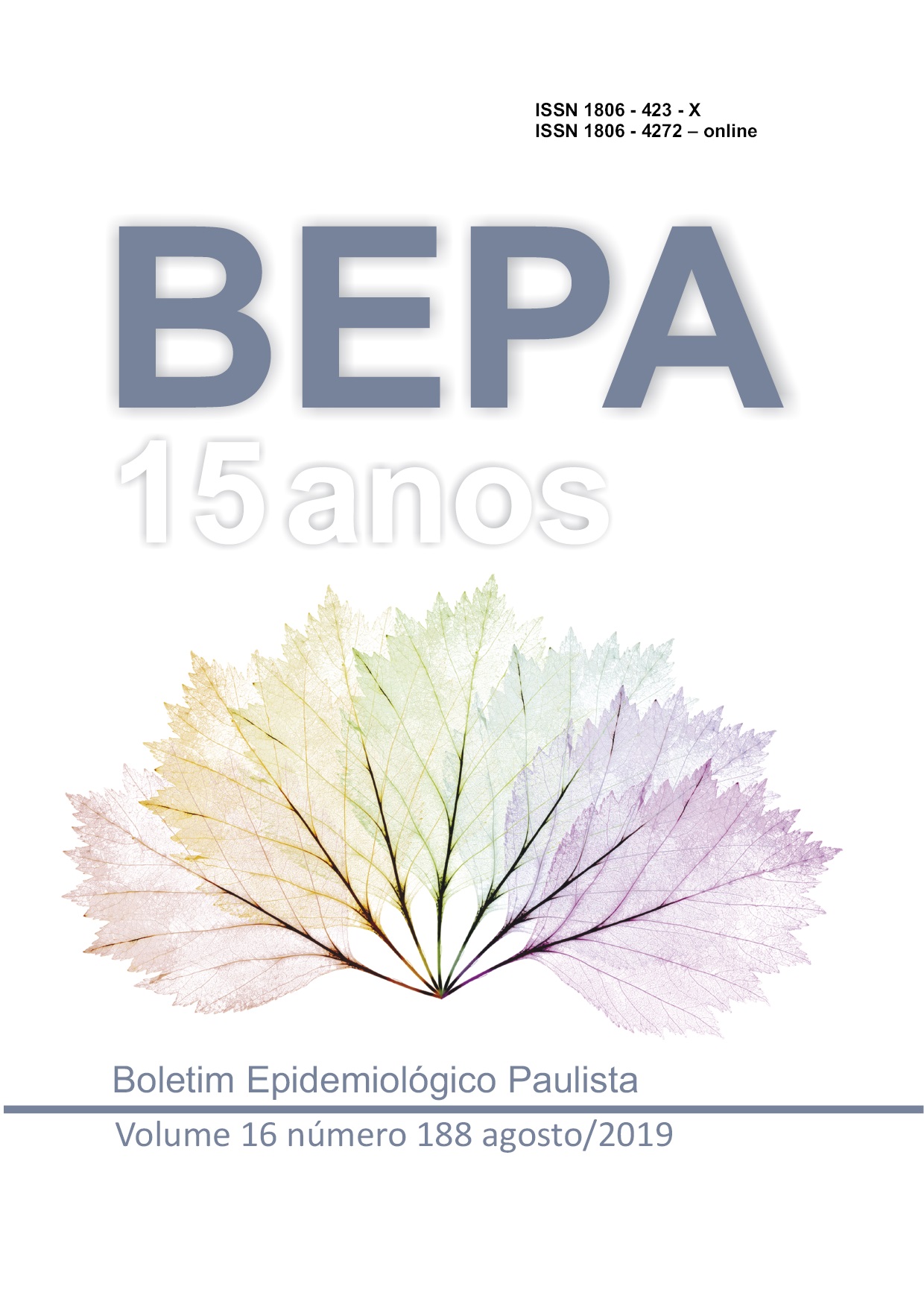Abstract
Introduction: Tuberculosis still afflicts millions worldwide, with a
considerable number of cases in Brazil, mainly in the central region of the city
of São Paulo. A significant proportion of patients needs more than a single
course of treatment, demanding a better understanding about the causes and
consequences of these retreatments. Objective: To study the demographic,
epidemiological and clinical characteristics of patients with more than one
treatment for tuberculosis notified between 2008 and 2016, in the Central Region
of São Paulo Municipality. Methods: Cross-sectional epidemiological study
with secondary data obtained from TBWeb system of São Paulo State Health
Department. Inclusion criteria: those reported and treated as a tuberculosis case
in the central region of São Paulo City at least twice between 2008 and 2016.
Demographic, epidemiological and clinical data were analyzed with SPSS
21.0. Results: Among 4105 patients with tuberculosis in the central region of
São Paulo, occurred 570 retreatments in 249 patients. Of 249 patients 72.3%
were male, mean age 37.2±14 years old, being 113 HIV+. The most common
reasons for retreatment were: abandonment of previous treatment (59.4%),
relapse (28.1%), and treatment failure (10%). Forty-five patients (37.5% of
those tested) presented some degree of drug resistance. The outcomes of 249
patients were: cure (46.5%), abandonment (26.5%), and death (12%). HIV+
status and previous abandonment were associated with the worse outcomes.
Retreatment due to the previous treatment failure was associated with cure.
Conclusion: Multiples profiles occur in patients with many treatments in the
studied area. They are the heterogeneous group, with different needs to be met
by the health system.
References
Dheda K, Barry CE, Maartens G.
Tuberculosis. Lancet. 2016; 387:1211-26.
Ministério da Saúde (BR). Secretaria
de Vigilância em Saúde. Brasil Livre
da Tuberculose: evolução dos cenários
epidemiológicos e operacionais da doença.
Boletim Epidemiológico. 2019; 50:9
Martinez VN. Equidade em saúde: o caso
da tuberculose na comunidade de bolivianos
na cidade de São Paulo [dissertação].
São Paulo: Faculdade de Saúde Pública
da Universidade de São Paulo; 2010.
Reis DC, Almeida TA, Quites HF,
Sampaio MM. Epidemiological profile
of tuberculosis in the city of Belo
Horizonte (MG), from 2002 to 2008.
Rev. bras. epidemiol. 2013;16:592-602.
Ministério da Saúde (BR). Manual
de Recomendações para o Controle
da Tuberculose no Brasil [internet].
Brasília: Ministério da Saúde; 2011
[acesso em 19 abr 2017]. Disponível
em: http://bvsms.saude.gov.br/bvs/
publicacoes/manual_recomendacoes_
controle_tuberculose_brasil.pdf
Ministério da Saúde (BR). Secretaria
de Vigilância em Saúde. Indicadores
prioritários para o monitoramento do Plano
Nacional pelo Fim da Tuberculose como
Problema de Saúde Pública no Brasil.
Boletim Epidemiológico. 2017; 48:8.
Centers for Disease Control and Prevention
(CDC). Plan to combat extensively drugresistant tuberculosis: recommendations
of the Federal Tuberculosis Task Force.
MMWR recomm. rep. 2009; 58(RR-3):1-43.
Fiske CT, Yan F, Hirsch-Moverman Y et al.
Risk factors for treatment default in close
contacts with latent tuberculosis infection.
Int. j. tuberc. lung. dis. 2014;18(4):421-7.
O’Donnell MR, Daftary A, Frick M
et al. Re-inventing adherence: toward
a patient-centered model of care for
drug-resistant tuberculosis and HIV. Int.
j. tuberc. lung. dis. 2016;20(4):430-4.
Trajman A, Long R, Zylberberg D,
Dion MJ, Al-Otaibi B, Menzies D.
Factors associated with treatment
adherence in a randomised trial of latent
tuberculosis infection treatment. Int. j.
tuberc. lung. dis. 2010; 14(5):551-9.
Rubinowicz A, Bartlett G,
MacGibbon B, Greenaway C,
Ronald L, Munoz M, et al. Evaluating
the role of primary care physicians in
the treatment of latent tuberculosis:
a population study. Int. j. tuberc.
lung. dis. 2014; 18(12):1449-54.
Dheda K, Gumbo T, Maartens G et
al. The epidemiology, pathogenesis,
transmission, diagnosis, and management
of multidrug-resistant, extensively
drug-resistant, and incurable tuberculosis.
Lancet Respir Med. 2017; 5:291-360.
Ragonnet R, Trauer JM, Denholm
JT, Marais BJ, McBryde ES. High
rates of multidrug-resistant and
rifampicin-resistant tuberculosis among
re-treatment cases: where do they come
from? BMC infect. dis. 2017;17:36.
Theron G, Jenkins HE, Cobelens F,
Abubakar I, Khan AJ, Cohen T, et
al. Data for action: collection and
use of local data to end tuberculosis.
Lancet. 2015; 386:2324-33.
Wejse C, Patsche CB, Kuhle A, Bamba
FJV, Mendes MS, Lemvik G et al. Impact
of HIV-1, HIV-2, and HIV-1+2 dual
infection on the outcome of tuberculosis.
Int. j. infect. dis. 2015; 32: 128-34
Nliwasa M, MacPherson P, Gupta‐Wright
A, Mwapasa M, Horton K, Odland JØ,
et al. High HIV and active tuberculosis
prevalence and increased mortality
risk in adults with symptoms of TB: a
systematic review and meta‐analyses.
J. int. aids soc. 2018; 21(7):e25162.
Ministério da Saúde (BR). Secretaria de
Vigilância em Saúde. Implantação do Plano
Nacional pelo Fim da Tuberculose como
Problema de Saúde Pública no Brasil:
primeiros passos rumo ao alcance das metas.
Boletim Epidemiológico. 2018; 49:11
Cardoso MA, do Brasil PEAA, Schmaltz
CAS, Sant’anna Fm, Rolla VC. Tuberculosis
Treatment Outcomes and Factors
Associated with Each of Them in a Cohort
Followed Up between 2010 and 2014.
Biomed Res Int. 2017;2017:3974651.
Hirsch-Moverman Y, Daftary A, Franks
J, Colson PW. Adherence to treatment for
latent tuberculosis infection: systematic
review of studies in the US and Canada. Int.
j. tuberc. lung. dis. 2008; 12(11):1235-54.
Muller AM, Osorio CS, Silva DR, Sbruzzi
G, Dalcin PTR. Interventions to improve
adherence to tuberculosis treatment:
systematic review and meta-analysis. Int.
j. tuberc. lung. dis. 2018; 22(7):731-40.
Menzies D, Adjobimey M, Ruslami R et al.
Four Months of Rifampin or Nine Months
of Isoniazid for Latent Tuberculosis in
Adults. N. Engl. j. med. 2018; 379:440-53.

This work is licensed under a Creative Commons Attribution 4.0 International License.
Copyright (c) 2022 Flávio Guinsburg Hamburger, Maria Josefa Penon Rujula




